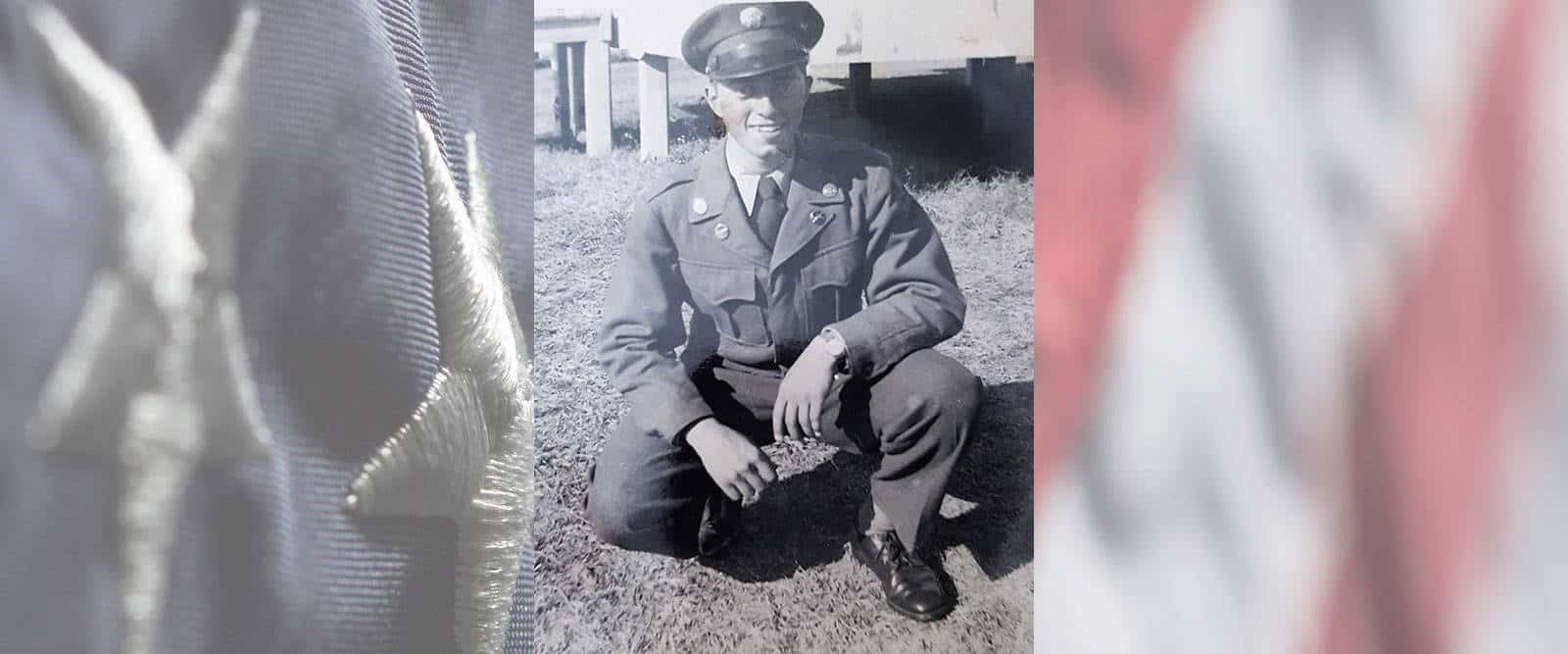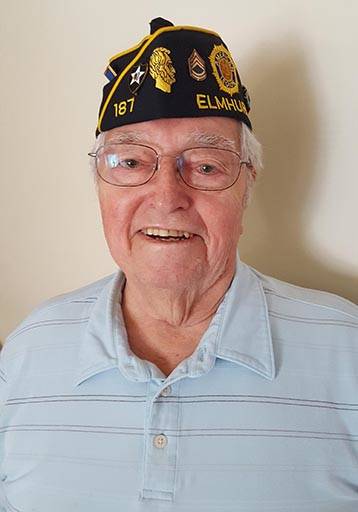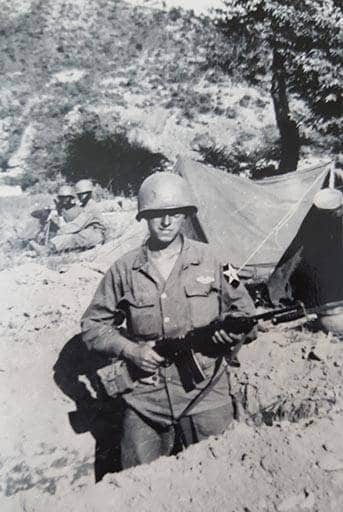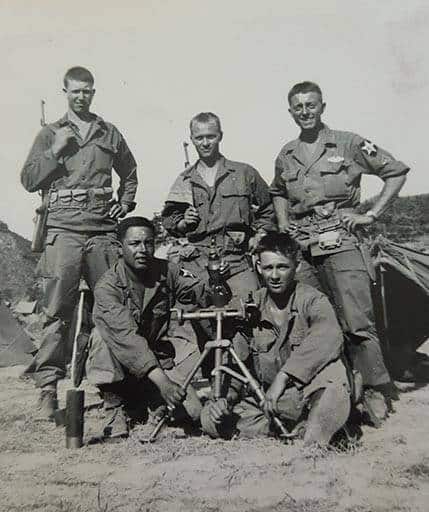U.S. Army Korean War Elmhurst, IL Flight date: 08/09/17
By David Koziol, Honor Flight Chicago Veteran Interviews Volunteer
Andrew Dziagwa was born and raised in the north Chicago neighborhood of Belmont Cragin. He was the son of Polish immigrants like many other residents of that neighborhood. While in the 7th grade of grammar school, he learned to play the trumpet. At age fourteen he started playing in a local polka band. In high school, he played in the school orchestra and marching band. He attended Wright College as a Music Major and earned a two-year degree. In October 1950, twenty-one-year-old Andy was drafted into the U.S. Army for a period of two years.
Andy recalls the day he reported for his induction at Ft. Leonard Wood, MO. It was October 10, 1950 and Andy says, “I reported with my buddies from the neighborhood, Tom and Ray.” Ray was sent to basic training at Fort Pickett, VA. Andy and Tom were sent to Ft. Polk, LA for their basic training. While at Ft. Polk, Andy and Tom were assigned to separate companies. Their buddy Ray would do his tour of duty in Germany, while Andy and Tom would be less fortunate and end up in Korea but they both did survive the war!
During basic training, Andy and Tom were assigned to an Oklahoma National Guard unit of the 45th Infantry Division, which was low on manpower. The Chicago recruits got along fine with the Oklahoma recruits during basic training. Andy told his superiors that he would like to be in the band and play his trumpet. He was told there were already too many trumpet players in the band, so Andy would become a rifleman instead. After basic Andy was one of twenty men chosen from each company of the guard unit to be transferred to FECOM, Far East Command. Andy was given a thirty day leave before reporting to Camp Stoneman, CA. Andy recalls “They told me not to bring any summer clothes to California.” He concluded, “I was pretty sure I was going to Korea.”
Andy’s conclusion was correct. When he reported to Camp Stoneman, he was immediately flown to Camp Drake, Tokyo, Japan for eventual deployment to Korea. While at Camp Drake, all the new arrivals received brand new rifles and clothing. Andy’s journey to Korea included many stops. First, he was transferred by train to Camp Mower, Sasebo, Japan, then by ship to Pusan, Korea, arriving there in March 1951. Next it was flatbed trucks to a train yard and then a train ride to a forward camp. From this camp, it was another flatbed truck to a location where Andy and the rest of the men were told to get out. Andy and a buddy had to sleep on a poncho covered by another poncho. The snaps of the ponchos froze together during the night and they struggled to get out the next morning. The men were awoken by their new platoon leader Lt. “Pete” Miceli. He told them welcome to Korea and to Company E, 9th Infantry Regiment, 2nd Infantry Division.
Lt. “Pete” asked Andy “What do you know about mortars?”, Andy replied “I never even saw one.” Lt. Pete said, “Doesn’t matter, I’ll train you.” Andy was now a mortarman in the U.S. Army and assigned to a 60mm mortar squad in Company E. Andy would spend much of his time on the front lines above and around the 38th Parallel. His first job was ammo bearer and he quickly progressed up the line to assistant mortar gunner and then to mortar gunner, as a Corporal. Andy remembers his first time in combat. His Company E mortar platoon was in support of Company F and their assault on a hill. Andy says, “My company captain was yelling ‘cease-fire, cease-fire’ and I got a sick feeling that I just mortared our own men.” Surprisingly, the captain congratulated Andy for taking out the three-man enemy machine gun nest which was Company F’s objective.
Andy may have been lucky that day, but was also very good at his job. He progressed quickly in the platoon and was promoted from gunner to squad leader, as a Sergeant. Then he became section sergeant, supervising three 60mm mortar squads. Andy was later promoted to Sergeant First Class and took over command of the platoon when Lt. “Pete” was transferred out of the company. Andy commanded his three 60mm mortar squads plus three 57mm recoilless rifle squads which constituted the full mortar platoon.
Andy and this platoon participated in many combat operations. These included Operation Killer, Operation Ripper, May Massacre and actions along the Kansas Line near Bloody Ridge and Heartbreak Ridge. Along the Kansas Line on August 2, 1951 Andy was given orders to take out an enemy position. This position was spotting U.S. supply lines in the rear and directing enemy fire. The enemy was uphill and about 4,000 yards out to their front. Two squads, one from Company F, and one from Company G had failed to take it out the two previous days. It was now Company E’s turn.
Instead of a squad, Company E sent out a platoon with Andy in command on the third day. About 2,000 yards out they ran into the same stiff resistance of the two previous days. Andy says, “They were flinging grenades like snowballs.” Three men were wounded out front and Andy along with his two men went to their aid. While advancing cautiously and watching for trip-wire they were confronted by three Chinese enemy soldiers who Andy and his two men quickly eliminated. Suddenly Andy heard a big explosion as a grenade went off and Andy was knocked to the ground. Blood was running down his neck, shoulder and his right arm. Out of the three men they went to recover, they found two, and only the cartridge box of the third. Injured, Andy raced back downhill thinking he was bleeding to death. He made it back, got patched up at an aid station and was sent to the hospital. Andy later learned that the enemy position they could not eliminate was a Chinese Regimental Command Post, a much larger unit than expected.
While in the hospital Andy was told he had shrapnel fragments lodged in his neck close to the spine and deep in the muscle of his right shoulder. The doctors decided not to remove the fragments because the surgery could cause more damage. Andy recovered from the wounds but the fragments remain in him to this day. While in the hospital Andy was also told he was being recommended for a Bronze Star for his actions on August 2, 1951, but he never received it. However, he did receive the Purple Heart. By late September, 1951, Andy was back with his platoon in Company E on the front lines ready to participate in the final phase of Heartbreak Ridge.
On October 9, 1951, the 2nd Battalion (Companies E, F, G and H) of the 9th Infantry Regiment assaulted and captured Hill 1005 while inflicting seventy casualties to the enemy. Andy participated in this assault with Company E. The next day the 1st Battalion of the 9th Infantry Regiment passed through 2nd Battalion still occupying Hill 1005 to capture Hill 1040 ending the Heartbreak Ridge Campaign. Shortly after Heartbreak Ridge Andy developed a 104-degree temperature and was pulled off the line.
Andy returned to the hospital where a nurse commented that he was just there. He replied, “I liked it here so much I wanted to come back.” While there he was diagnosed with “amoebic dysentery” and lost a significant amount of weight, down to 135 pounds. When he eventually recovered and his time in Korea was over, he had served his ten months in combat. Andy was offered a battlefield commission of 2nd Lieutenant but turned it down because it required another six months in Korea. Andy just wanted to go home. He spent Christmas 1951 in Japan and arrived back in the states shortly thereafter to enjoy a thirty-day leave.
After leave Andy reported back to Ft. Leonard Wood, MO. He was assigned to company D, 61st AAA Battalion, 6th Armored Division as a platoon leader of recruits that were doing their basic training. He would get a new class of recruits to train every eight weeks. Andy served until July, 1952, being honorably discharged after twenty-one months of service. Because of his ten months in combat, he was discharged three months early. His service awards include the Purple Heart, National Defense Service Medal, Korean Service Medal w/4 Campaign Stars, United Nations Korean Service Medal, and the Republic of Korea War Service Medal. He also earned the Combat Infantry Badge and a Presidential Unit Citation.
Andy could now get back to what he loved doing, playing the trumpet. He again joined a polka band and played in several different bands, mostly on the weekends. He did this for over fifty years. That is how he met his wife Lorraine, who he married in 1954. They raised four children, Denise, Mark, Janice and Darlene, first residing on the southwest side of Chicago and later moved to Elmhurst, where Andy and Lorraine reside today. Andy worked in a printing plant for twenty-five years until retiring as a supervisor. When not working, he wrote and performed polka songs under the name “Andy Day” and played with a well-known polka band the Ampol-Aires. He was inducted into the International Polka Association Hall of Fame in 1995.
Andy is a long-time member of the American Legion. Initially, he was a proud member of Palmer Post 65 in Chicago for over forty years. Now, after the recent disbanding of Post 65, he belongs to the T.H.B. Post 187 in Elmhurst. Andy and his wife Lorraine play bingo there every Wednesday night.
Andy, we thank you for your exceptional and heroic military service during the Korean War. Enjoy your much-deserved Honor Flight to Washington, D.C.






